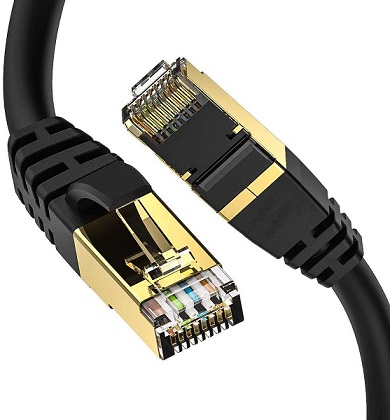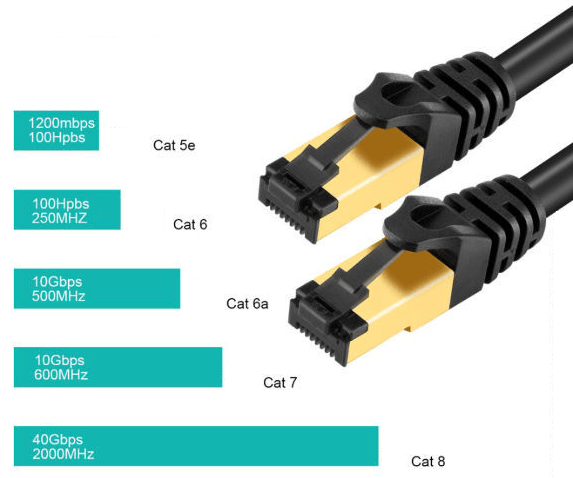After the arrival of the super-fast fiber optic cables, it was actually believed that the Ethernet cables will not sustain any longer in the industry. However, with evolving technologies, the copper-based Ethernet cables managed to sweep the user’s attention quite amazingly, thanks to the new Cat8 cables that made everyone look at Ethernet cables one more time.
But, before we dig deep into this topic, let’s take a look at what Cat8 Ethernet cable is, and what it offers to us? Hence, we will be covering everything about the Cat8 cables in this article. In case you are curious to know what makes these cables so special, make sure to read this article until the end.
Outline
ToggleWhat is Cat8 Ethernet Cable?
You might already know what an Ethernet cable does, but do you know about the term Cat8 associated with it? What does it signify? Well, just like we see various standards proposed by IEEE in the case of Wireless Fidelity. The Cat8 or Category 8 is also one such standard given by IEEE for Wired connections, i.e., Ethernet. Compared to the previous standards, the Cat8 cable is surely the fastest in terms of data transfer speeds and is also backward compatible with all the previous standards.
Apart from that, what makes it different from the previous generation Ethernet cables is its shielding. In all sorts of Ethernet cables, you will find the STP design where each copper wire is shielded and twisted in pairs to eliminate most of the electromagnetic interference from the outer environment.
But, when it comes to Cat8 cables, the design is even better as each of the twisted pair cables comes with its own separate foil protection layer that even eliminates the minor interference and crosstalk caused by the pairs of cables inside the jacket. As a result, the Cat8 cables can deliver the data at the highest speeds possible and are much more reliable than any other previous generation Ethernet cable at the moment.
Cat 8 used for?
Since the Cat8 cables are quite reliable and carry more bandwidth of data at higher transfer speeds. These cables are highly useful in places where 40Gbase-T and 25GBase-T networks are more often used, like in data centers, server rooms, etc. The Cat8 Ethernet cables use the RJ45 connectors, which are quite convenient while connecting networking devices like switches and routers with the system. Thanks to the Shielded design of such cables, the effect of EMI/RFI line noise is minimal, and the transmission is done in the best quality possible.
How fast is Cat8 Cable?
We have already mentioned many times that the Cat8 Ethernet cables are quite fast in terms of data transfer speeds, right? But, how fast are they actually? For a quick review, we can compare its speeds and other factors with the previous generation cables such as Cat7, Cat6, etc.
In general, the Cat7 cables operate on a standard bandwidth of 600MHz only, whereas a Cat8 cable can operate at much higher 2000MHz bandwidth, making them highly reliable for fast communication. On the other hand, if we compare the speeds, both Cat6 and Cat7 cables have a max 10 Gbps speed whereas Cat8 is fit for 25 Gbps and 40 Gbps connections.
Basic Specs of Cat8 Ethernet
In case you are interested to know about the basic specifications of a general Cat8 Ethernet cable, we are listing them down below so that you can get a glance at it.
| Category | Cat8 |
| Connectors | RJ45/RJ45 |
| Booted | Yes, Ferrari-Style, Snagless |
| Shielded | Pair Foil Shielded/ 4 Pair Braided Shield |
| AWG | 24AWG |
| Bandwidth | Up to 2000MHz |
| Jacket | PVC Jacket |
| Conductor | Stranded |
| Conductor Material | Copper |
| Contact Gold-plating | 50 Micron |
| Backward Compatible | Yes |
| Max Data Transfer Rate | 40 Gbps |
Ethernet Speed Comparison
As we know, the Cat8 Ethernet cable is the fastest in its class, let’s take a look at how ahead it is from the previous generation cables in terms of speed and bandwidth capabilities.
| Category | Bandwidth | Data Transfer Speed | Shielding |
| Cat 5e | 100 MHz (Up to 350Mhz) | 1000 Mbps | UTP or STP |
| Cat 6 | 250 MHz (Up to 350Mhz) | 1000 Mbps | UTP or STP |
| Cat 6e | 500 MHz (Up to 550Mhz) | 10 Gbps | UTP or STP |
| Cat 7 | 600 MHz | 10 Gbps | Shielded Only |
| Cat 8 | 2000 MHz | Up to 40 Gbps | Shielded Only |
Do you need a Cat 8 Ethernet cable for gaming?
As you can see from the above speed comparison table, the Cat 5e and other cables deliver decent speeds as well. Since games do not use much in terms of bandwidth and do not require such high speeds either, utilizing a Cat 8 cable for gaming is just not necessary. However, the thing to keep in mind is that you should pick an Ethernet cable according to what your internet plan offers. If you have opted for a 10Gbps plan and still use a Cat 5e cable, it will bottleneck the connection speeds you should always avoid.
It’s not primarily recommended to only use a Cat8 cable if you want to have the best gaming experience, you can use a Cat 6 or Cat 7 cable as well. However, if you have other requirements where you need to utilize cutting-edge internet speeds (either for research, testing or experimenting), using the Cat8 Ethernet cable is the best choice you have. Yes, the Cat8 cables have much better transmission quality due to low latency and low signal interference. But, when it comes to gaming, there will be no significant difference between the performance of a Cat7 or Cat8 cable.
Conclusion
Wrapping up, you can see the Cat8 Ethernet cable is quite superior to its predecessors in all ways. If you have high-speed data transfer requirements and have a 25+ Gbps internet plan, the Cat8 cable is the best option to pick as it can flawlessly handle such speeds.
Moreover, these cables are much more reliable and have better build quality as compared to any other category of Ethernet cables. We hope whatever we have mentioned about the Cat8 cables in this article is clear to you. In case you have any doubts regarding any fact about the Cat8 Ethernet cables, you can freely ask us in the comments section below.




